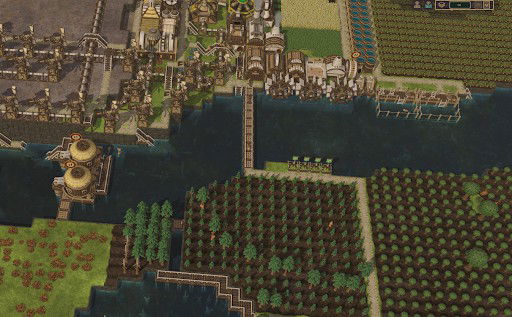Timberborn is a survival and building game set in a post-apocalyptic world where humans have been replaced by a civilization of highly developed beavers. In hard mode, the difficulty increases considerably, demanding careful planning and efficient resource management. Here are 7 essential tips for thriving in Timberborn's hard mode.
The numbers that will be presented here are always approximated upwards, including a safety margin so the population never perishes.
Learn how to correctly calculate water in droughts
To properly manage water during droughts, you must correctly calculate consumption and storage capacity. The basic formula for calculating the amount of water needed is:
Water Required=Number of Beavers × Daily Consumption per Beaver × Duration of DroughtDaily Consumption per Beaver: In Timberborn, a beaver consumes about 2-3 units of water per day. Let's go for 3, so there won't be any problems.
Drought Duration: Determine how many days of drought you expect. It is usually good practice to add a safety margin.
Calculation Example:
Suppose you have 20 beavers and expect a 10-day drought. The calculation would be:
Water Required=20×3×10=600 units of waterYou probably won't have the capacity to store so much water at the beginning of the game, so you'll have to pump water even during the drought, so follow the tip below too:
“Pump water away from crops and in places at least 2 squares deep”
- Leon
It is important that water pumps are not installed close to your crops and cultivation areas. Pumps consume large amounts of water, and if they are located close to crops, they can quickly deplete water resources in those areas, harming the growth of your crops. Place pumps in separate locations to ensure that the water used for irrigation is sufficient and does not overload the growing system. I always recommend it at the end of the map or after the water flow has passed through the plantations.
And to ensure a reliable water supply, install your pumps in locations with at least 2 levels of water depth. Water at greater depth tends to be more stable and less susceptible to temporary droughts. This ensures that your pumps can continuously extract water without the risk of rapid depletion of the resource. Furthermore, this depth provides a more constant and long-lasting flow of water, reducing the likelihood of supply problems during critical periods.
See the example on a map below:

Pump water at the end of the map, in a drop area which allows 4 distance depth
Calculate the amount of evaporation before building your dam
The amount of evaporation per day is almost 5%, but as it can change if there are buildings or plants, let’s set it at 10% to be safe. That is, every 10 days the entire surface area will evaporate, leaving only the water 1 distance deeper.
Now let's think, if we need this area to keep our crops alive, our dam needs to replace it as it evaporates. To that end, I created the following formula for the minimum volume of the dam:
Minimum dam volume = (Drought Duration / 10) x Size of water surface next to plantation + (Drought Duration / 10) x Dam surface size + Dam surface size
The first part of the equation (Drought Duration / 10) x Size of the water surface next to the crops concerns the number of times you will have to open the floodgate and replace the water responsible for your crops. If your dam does not need to be opened because it already touches your crops, you can ignore this part of the equation.
The second part is the dam's own evaporation (Drought Duration / 10) x Dam surface size.
The third part only needs to be added if the dam is at the same height as the river that supplies the crops, that is, not all the water will leave the dam to supply the river and will be left still.
Let's take an example for a 20-day drought and the surface area of the Dam being 6 x 6 = 36 and the water surface area next to the crops being 20 x 6 = 120:
Minimum dam volume = (20 / 10) x 120 + (20 / 10) x 36 + 36 = 348
That is, the dam must have at least 312 in volume. To build a dam of this size, the ideal is to be 3 in height (since the maximum floodgate is 3 in height) and I can think of a width of 10 and a length of 15. Total volume will be 450, with water remaining if it’s necessary to pump.
Note why it is much better if your plantation is adjacent to the dam, so only evaporation from the dam would be counted. At 3 tall, it would already survive a 30-day drought.
Minimum Dam Volume = (20 / 10) x 120 + (20 / 10) x 36 + 36 = 348
Being thirsty is bad, but hungry is worse
If all your water calculations go wrong, your beavers will still survive 2 to 3 days thirsty. As soon as the drought ends, the water will return, putting them to work 24 hours guarantees the production of water and consequently they no longer feel thirsty. Have you ever thought about hunger?
If the food runs out and the crop perishes due to drought, there will still be 4 days until the carrots grow and are harvested to feed your poor beavers. In other words, food is essential and terribly more important than water. Focus on food storage.
Each beaver uses around 2.5 units of food per day. That is, your minimum food stock should be 4 days of food in case the crop dies, and a few days on top for safety, I would put at least 10 days for safety in case there’s a problem that causes your crops to die in the middle of the drought. That is:
Minimum food stock = (4 days for carrot growth + 10 days for safety) x 2.5 x number of beaversIf you have a population of 20 beavers, you should have:
Minimum food stock = 14 x 2.5 x 20 = 700700 food units means at least 1 full farm and 3 medium stocks, so get ready to build them.
Size your farms right
Since food consumption is 2.5 units per beaver per day, we need to think about how much each farm space produces per day.
Carrot farms produce 0.75 carrots per day, so to feed 1 beaver, we need at least 3.33 carrot spaces. To feed 20 beavers, we will need at least 66 spaces or an area measuring 11 by 6.
If you don't have much space, you can produce bread. For this, you will need wheat, 1 space of wheat grows 3 wheat every 10 days. 1 wheat can produce 1 flour in the mill and 1 flour can produce 5 loaves of bread in the bakery. Note then that for every 10 days, you can produce 15 loaves of bread, a speed of 1.5 loaves per day. Therefore, 1.6 spaces of wheat will be needed per beaver. A population of 20 beavers will need 32 wheat spaces (in addition to the mill and bakery space).
These are the minimum numbers, but I always recommend adding 30% to 50% more to be able to stock up on food.
At first worry about survival, not happiness
The beginning of the game is extremely difficult, making up for the fact that after you stabilize, you will have to work hard to kill your colony. That said, pay attention to the following tips:
- Administer the correct amount of sleep for them, put them to work for 24 hours if necessary before droughts
- Focus quickly on the sawmill and forestry. These in turn will allow you to build your dam quicker
- Roads are free, so make them wherever you find forests to cut down the trees. Finding wood will be your main issue at the beginning.
- Produce carrots, don't play with the food or try to go for variety at the beginning.
- Only take up housing when it's guaranteed that Bad Tide won't kill you. The wood at the beginning is for the dam!
Create areas and make your beavers walk a standard path
See how I divided my colony below:

The top part of it is all the housing, creating stairs, you can get all the beavers to live in the same “building” and go out on the same road searching for water and food. Doing this will ensure that they will pass through areas where well-being influences, such as bushes, lanterns, roofs.
Also build your home in areas that water does not touch, after all, there is no reason for the ground to be fertile in this place. Note that I also stored food and materials in a gray area, allowing the fertile area to be used only to store water, farm, forest and a little industrial part, since I use a Water Wheel.
The industrial part has to be in the same location, after all, most buildings need energy, and they need to touch each other.

Note that the energy network ideally comes from a windmill, since this type of energy is stronger. For this, you will also need gravity stacks, which is why it is also recommended that the industrial area be built at high heights!
I hope you liked the tips!














— Comments 0
, Reactions 1
Be the first to comment